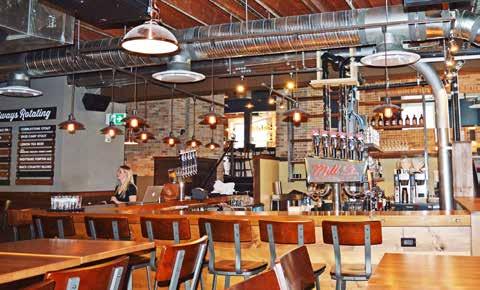
4 minute read
A Year Like No Other
BY DAVID NUTTALL
If you are reading this in the spring of 2021, you have just lived past the anniversary of COVID19 becoming a major part of life. In Alberta, the first case was identified on March 5, 2020 and throughout that month various restrictions were enacted regarding businesses, schools, offices, stores, events, and personal gatherings. While liquor stores would remain open, the closure of restaurants, bars, breweries, distilleries and the cancellation of events, had a huge impact on the liquor industry.
Advertisement
Through most of last March, people were panic buying liquor like it was toilet paper. Once the government declared liquor stores an essential service, things quieted down a little. Nevertheless, that did not help the foodservice industry that lost their dine-in customers. To remain open, locations had to develop a carry out and/or delivery service and plunge into survival mode.
When it was announced that liquor off-sales could be included with delivery and pick up, it helped allay the bleeding a little. However, lost sales due to two (later four) months of mandated closures will never be recovered. Statistics Canada reported eating and drinking establishment sales across the country fell by 28.2 percent compared to 2019, the largest drop on record. Bars, taverns, catering, and food trucks were the most affected, with sales dropping 48.3 percent in 2020. No doubt the foodservice and hospitality industries were among the hardest impacted by COVID-19, leading to layoffs, the permanent closure of several locations, and putting many newly planned locations on hold.
With a lost summer festival season, sagging tourism and no foreign visitors, restaurants, breweries, and other producers had to get creative. Dine-in capacity and hours were restricted, so deliveries became the essential connection to the community, while social media disseminated information to the masses.
Many consumers did favour locally owned establishments over national and multinational businesses, attempting to support the neighbourhood “little guy”. When the second closure came in December many locations were better prepared than in the spring. However, reopening also comes with additional expenses, from cleaning to construction requirements and other logistical issues needed to become Alberta Health Services compliant.
For Alberta liquor producers, the whole year was rife with havoc. No one had ever been through a pandemic before, and certainly none had “outright closure” built into their business plans. Most producers are so new to the scene, they are constantly adjusting production levels, recipes, and suppliers with other unforeseen factors. Breweries, especially, depend on taproom traffic and keg sales to restaurants and other locations for much of their business. Remove that supply line and growler fills just don’t cut it by themselves. Many breweries turned their excess beer supply into hand sanitizer and donated it for free. Alberta craft breweries made up for volume by producing variety; regularly brewing an assortment of new beers to keep their customers engaged. Liquor stores stay busy throughout the pandemic since many consumers
take to drinking at home instead of going out. This actually stretches their purchasing power, as exemplified by the year-end statistics. Alberta Gaming, Liquor and Cannabis reports the volume of liquor sales grew by just over 4 percent in 2020 compared to 2019. All liquor categories, except beer, showed an increase in sales, led by coolers (+62 percent) and tequila/ mezcal (+14 percent), despite some supply issues throughout the year (due to several factors beyond COVID).
Even the formally stagnant vodka category grew by 13 percent, driven by those interested in making homemade infusions or sanitizers. Wine sales increased by 2.3 percent, with Canadian wines (read: BC) leading the way (+4 percent). Beer was the only category that fell in volume (-3 percent), mostly hitting the big producers who lost their restaurant accounts for a quarter of the year and all their events, from festivals to professional sports.
Losing the Calgary Stampede and Edmonton K-Days alone disrupts Molson and Labatt more than it does craft breweries. Alberta craft breweries and distilleries still grew in number, with more than a dozen locations opening in 2020. Not quite equal to the average of over three dozen producers per year that opened between 2016

and 2019, but that level of growth was unsustainable over the long term. Alberta did lose three breweries (Calgary’s Caravel and Mill Street, and Sylvan Lake’s Undercurrent) to closure, and another (Banded Peak of Calgary) was purchased by Labatt. There are still dozens of new locations on the drawing board, biding their time until things return to “normal”.
Liquor agencies and importers certainly didn’t do too much damage to their promo budgets in 2020. With all festivals and trade shows cancelled after February, and no formal or informal tastings allowed, many transitioned to virtual events, which let consumers purchase sample packs through liquor stores and then log on to a special website that brought the speaker into their home to guide and educate. In late 2020, the AGLC permitted liquor stores to repackage and reseal bottles into sample sizes, thus expanding the options available. As 2021 progresses, our lives are still in a holding pattern. Our restaurants, liquor stores, agencies, and producers are still in uncharted waters. So even after current restrictions are well in our rear view mirror, continue to support as many local services, suppliers, and manufacturers as you can. Their very existence relies on you.
Mill Street Brewery
David has worked in liquor since the late 1980s. He is a freelance writer, beer judge, speaker, and since 2014, has run Brew Ed monthly beer education classes in Calgary. Follow him @abfbrewed


